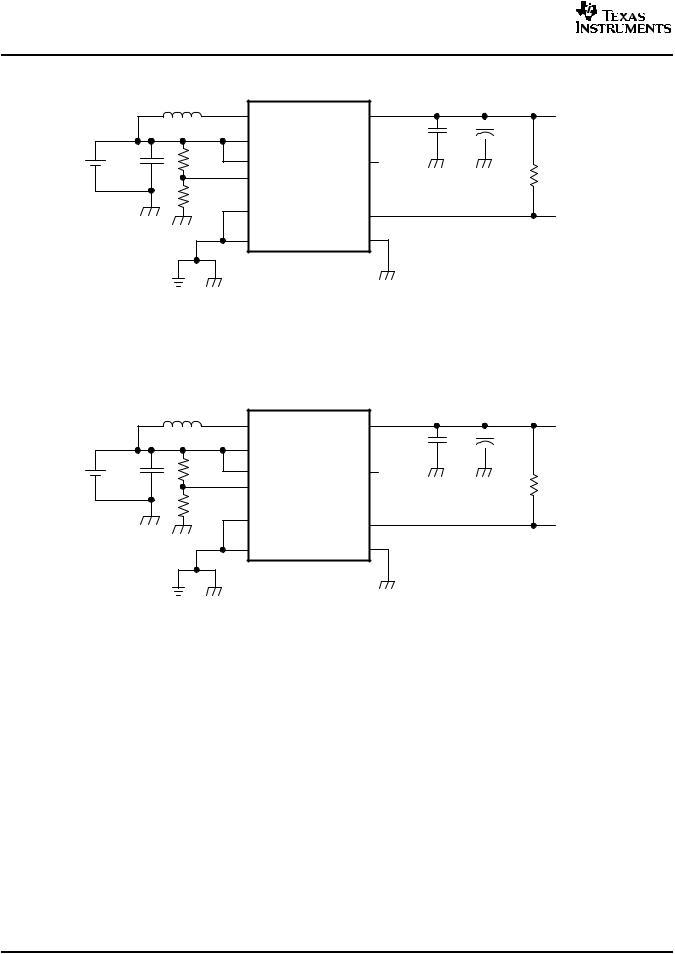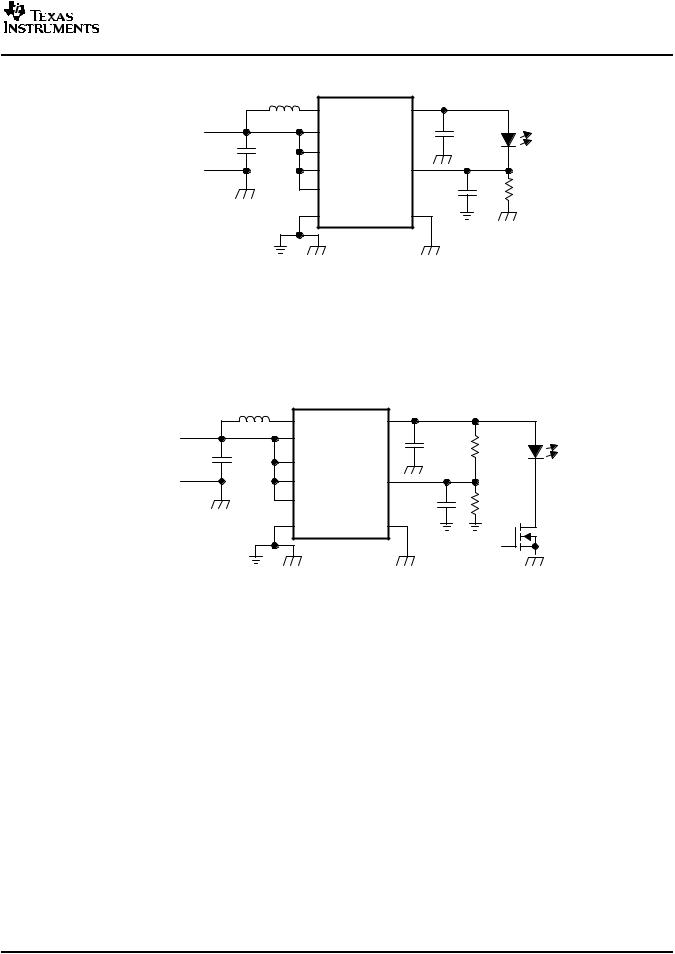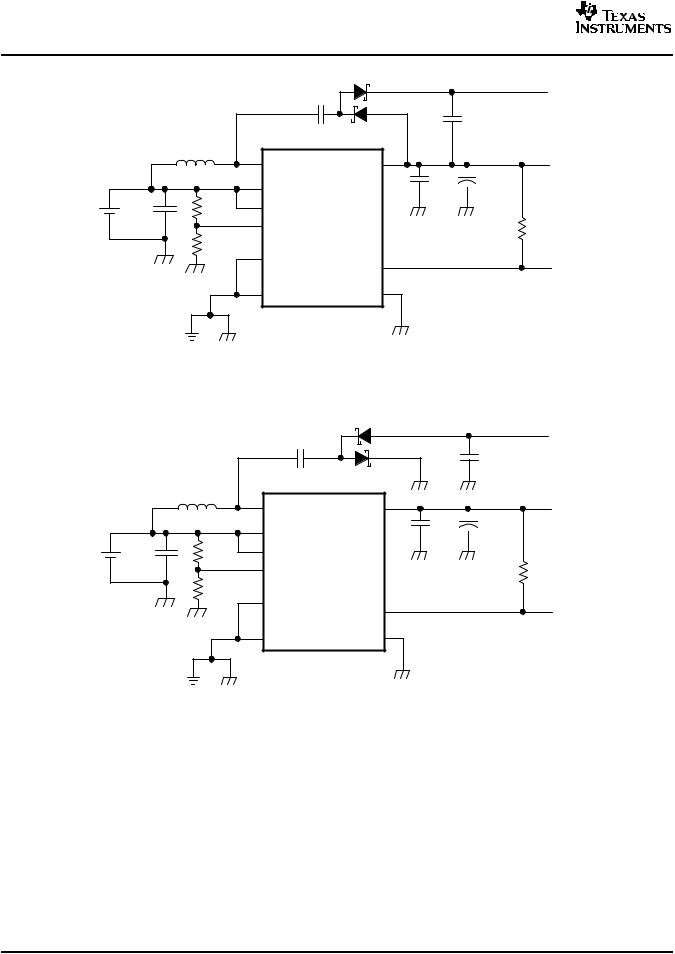
- •FEATURES
- •APPLICATIONS
- •DESCRIPTION
- •ABSOLUTE MAXIMUM RATINGS
- •DISSIPATION RATINGS TABLE
- •RECOMMENDED OPERATING CONDITIONS
- •ELECTRICAL CHARACTERISTICS
- •PIN ASSIGNMENTS
- •PARAMETER MEASUREMENT INFORMATION
- •TYPICAL CHARACTERISTICS
- •DETAILED DESCRIPTION
- •CONTROLLER CIRCUIT
- •Synchronous Rectifier
- •Down Regulation
- •Device Enable
- •Undervoltage Lockout
- •Softstart and Short Circuit Protection
- •Power Save Mode
- •Low Battery Detector Circuit—LBI/LBO
- •Low-EMI Switch
- •APPLICATION INFORMATION
- •DESIGN PROCEDURE
- •PROGRAMMING THE OUTPUT VOLTAGE
- •PROGRAMMING THE LBI/LBO THRESHOLD VOLTAGE
- •INDUCTOR SELECTION
- •CAPACITOR SELECTION
- •Input Capacitor
- •Output Capacitor
- •SMALL SIGNAL STABILITY
- •LAYOUT CONSIDERATIONS
- •APPLICATION EXAMPLES
- •THERMAL INFORMATION

TPS61020, TPS61024, TPS61025 TPS61026, TPS61027, TPS61028
TPS61029
www.ti.com
SLVS451D–SEPTEMBER 2003–REVISED FEBRUARY 2006
CAPACITOR SELECTION
Input Capacitor
At least a 10-µF input capacitor is recommended to improve transient behavior of the regulator and EMI behavior of the total power supply circuit. A ceramic capacitor or a tantalum capacitor with a 100-nF ceramic capacitor in parallel, placed close to the IC, is recommended.
Output Capacitor
The major parameter necessary to define the output capacitor is the maximum allowed output voltage ripple of the converter. This ripple is determined by two parameters of the capacitor, the capacitance and the ESR. It is possible to calculate the minimum capacitance needed for the defined ripple, supposing that the ESR is zero, by using Equation 6:
Cmin + |
IOUT |
VOUT * VBAT |
|
|
ƒ |
D |
(6) |
||
|
|
V VOUT |
||
Parameter f is the switching frequency and |
V is the maximum allowed ripple. |
|||
With a chosen ripple voltage of 10 mV, a minimum capacitance of 24 µF is needed. The total ripple is larger due to the ESR of the output capacitor. This additional component of the ripple can be calculated using Equation 7:
DVESR + IOUT RESR |
(7) |
An additional ripple of 16 mV is the result of using a tantalum capacitor with a low ESR of 80 mΩ. The total ripple is the sum of the ripple caused by the capacitance and the ripple caused by the ESR of the capacitor. In this example, the total ripple is 26 mV. Additional ripple is caused by load transients. This means that the output capacitor has to completely supply the load during the charging phase of the inductor. A reasonable value of the output capacitance depends on the speed of the load transients and the load current during the load change. With the calculated minimum value of 24 µF and load transient considerations the recommended output capacitance value is in a 47 to 100 µF range. For economical reasons, this is usually a tantalum capacitor. Therefore, the control loop has been optimized for using output capacitors with an ESR of above 30 mΩ. The minimum value for the output capacitor is 10 µF.
SMALL SIGNAL STABILITY
When using output capacitors with lower ESR, like ceramics, the adjustable voltage version is recommended. The missing ESR can be compensated in the feedback divider. Typically a capacitor in the range of 4.7 pF in parallel to R3 helps to obtain small signal stability with lowest ESR output capacitors. For more detailed analysis, the small signal transfer function of the error amplifier and the regulator, which is given in Equation 8, can be used:
A |
|
+ |
d |
+ |
4 |
(R3 ) R4) |
|
||
REG |
|
|
|
|
|
|
|||
|
VFB |
|
R4 (1 |
) |
i w |
0.9 ms) |
(8) |
||
|
|
|
|
||||||
LAYOUT CONSIDERATIONS
As for all switching power supplies, the layout is an important step in the design, especially at high peak currents and high switching frequencies. If the layout is not carefully done, the regulator could show stability problems as well as EMI problems. Therefore, use wide and short traces for the main current path and for the power ground tracks. The input capacitor, output capacitor, and the inductor should be placed as close as possible to the IC. Use a common ground node for power ground and a different one for control ground to minimize the effects of ground noise. Connect these ground nodes at any place close to one of the ground pins of the IC.
The feedback divider should be placed as close as possible to the control ground pin of the IC. To lay out the control ground, it is recommended to use short traces as well, separated from the power ground traces. This avoids ground shift problems, which can occur due to superimposition of power ground current and control ground current.
Copyright © 2003–2006, Texas Instruments Incorporated |
Submit Documentation Feedback |
17 |
Product Folder Link(s): TPS61020 TPS61024 TPS61025 TPS61026 TPS61027 TPS61028 TPS61029

TPS61020, TPS61024, TPS61025 |
|
|
|
|
|
|
||
TPS61026, TPS61027, TPS61028 |
|
|
|
|
|
|
||
TPS61029 |
|
|
|
|
|
|
|
|
SLVS451D–SEPTEMBER 2003–REVISED FEBRUARY 2006 |
|
|
|
|
|
|||
APPLICATION EXAMPLES |
|
|
|
|
|
|
|
|
|
L1 |
|
|
|
|
|
|
|
|
6.8 μH |
SW |
VOUT |
|
|
|
|
|
|
|
C2 |
|
C3 |
||||
|
|
|
VBAT |
|
||||
Battery |
|
|
2.2 |
μ |
F |
100 |
μ |
|
|
|
|
|
F |
||||
Input |
C1 |
R1 |
EN |
FB |
|
|
|
|
|
|
|
|
|
||||
|
10 μF |
|
LBI |
|
|
|
|
R5 |
|
|
|
|
|
|
|
||
|
|
R2 |
|
|
|
|
|
|
|
|
|
PS |
LBO |
|
|
|
|
|
|
|
|
|
|
|
|
|
|
|
|
GND |
PGND |
|
|
|
|
|
|
|
|
TPS61027 |
|
|
|
|
List of Components: |
|
|
|
|
|
|
|
|
U1 = TPS61027DRC |
|
|
|
|
|
|
|
|
L1 = EPCOS B82462-G4682 |
|
|
|
|
|
|
|
|
C1, C2 = X7R,X5R Ceramic |
|
|
|
|
|
|
|
|
C3 = Low ESR Tantalum |
|
|
|
|
|
|
|
|
www.ti.com
VCC 5 V
Boost Output
LBO
Figure 23. Power Supply Solution for Maximum Output Power Operating From a Single Alkaline Cell
|
|
L1 |
|
|
|
|
|
|
|
|
6.8 μH |
SW |
VOUT |
|
|
|
|
|
|
|
C2 |
|
C3 |
|||
|
|
|
VBAT |
|
||||
Battery |
|
|
2.2 |
μ |
F |
47 |
μ |
|
|
|
|
|
F |
||||
Input |
C1 |
R1 |
EN |
FB |
|
|
|
|
|
|
|
|
|
||||
|
10 μF |
|
LBI |
|
|
|
|
R5 |
|
|
|
|
|
|
|
||
|
|
R2 |
|
|
|
|
|
|
|
|
|
PS |
LBO |
|
|
|
|
|
|
|
|
|
|
|
|
|
|
|
|
GND |
PGND |
|
|
|
|
|
|
|
|
TPS61027 |
|
|
|
|
VCC 5 V
Boost Output
LBO
List of Components:
U1 = TPS61027DRC
L1 = EPCOS B82462-G4682
C1, C2 = X7R,X5R Ceramic
C3 = Low ESR Tantalum
Figure 24. Power Supply Solution for Maximum Output Power Operating From a Dual/Triple Alkaline Cell or Single Li-Ion Cell
18 |
Submit Documentation Feedback |
Copyright © 2003–2006, Texas Instruments Incorporated |
Product Folder Link(s): TPS61020 TPS61024 TPS61025 TPS61026 TPS61027 TPS61028 TPS61029

TPS61020, TPS61024, TPS61025 TPS61026, TPS61027, TPS61028
TPS61029
www.ti.com
SLVS451D–SEPTEMBER 2003–REVISED FEBRUARY 2006
Input 0.9 V to 6.5 V
L1 |
TPS61020 |
|
|
|
SW |
VOUT |
|
|
|
4.7 μH |
|
|
||
|
|
C2 |
D1 |
|
|
|
|
||
|
VBAT |
|
|
|
C1 |
|
22 μF |
|
|
EN |
|
|
||
10 μF |
|
|
|
|
LBI |
FB |
|
|
|
|
|
|
||
|
PS |
LBO |
C3 |
R1 |
|
10 nF |
|||
|
|
|
||
|
|
|
|
|
|
GND |
PGND |
|
|
List of Components:
U1 = TPS61020DRC
L1 = Sumida CDRH2D16-4R7
C1, C2, C3 = X7R, X5R Ceramic
D1 = White LED
Figure 25. Power Supply Solution for Powering White LED's With LED Currents Below 150 mA in Lighting Applications
Input 1.8 V to 6.5 V
L1 |
TPS61020 |
|
|
|
|
|
|
4.7 µH |
SW |
VOUT |
|
|
C2 |
D1 |
|
|
VBAT |
||
C1 |
|
R1 |
|
|
22 µF |
1.5 MΩ |
|
|
EN |
||
10 µF |
|
|
|
LBI |
FB |
|
|
|
|
||
|
PS |
C3 |
R2 |
|
LBO |
||
|
|
||
|
|
200 kΩ |
|
|
|
2200 pF |
|
|
|
|
|
|
GND |
PGND |
Q1 |
|
|
|
|
|
|
|
Flashlight |
|
|
|
Control |
List of Components:
U1 = TPS61020DRC
L1 = TDK VLF3010AT 4R7MR70
C1, C2, C3 = X7R, X5R Ceramic
D1 = OSRAM LWW57G
Q1 = Vishay SI1012R
Figure 26. Simple Power Supply Solution for Powering White LED Flashlights
Copyright © 2003–2006, Texas Instruments Incorporated |
Submit Documentation Feedback |
19 |
Product Folder Link(s): TPS61020 TPS61024 TPS61025 TPS61026 TPS61027 TPS61028 TPS61029

TPS61020, TPS61024, TPS61025 |
|
|
|
|
|
|
|
||
TPS61026, TPS61027, TPS61028 |
|
|
|
|
|
|
|
||
TPS61029 |
|
|
|
|
|
|
|
|
www.ti.com |
SLVS451D–SEPTEMBER 2003–REVISED FEBRUARY 2006 |
|
|
|
|
|
|
|
||
|
|
|
C5 |
|
|
|
|
|
VCC2 10 V |
|
|
|
DS1 |
|
|
|
|
Unregulated |
|
|
|
|
|
|
|
|
C6 |
|
Auxiliary Output |
|
|
|
|
|
|
|
|
|
|
|
|
|
0.1 μF |
|
|
|
1 μF |
|
|
|
|
L1 |
|
|
|
|
|
|
VCC1 5 V |
|
|
6.8 μH |
SW |
VOUT |
|
|
|
|
|
|
|
|
C2 |
|
C3 |
Boost Main Output |
|||
|
|
|
|
|
|||||
Battery |
|
|
VBAT |
2.2 |
μ |
F |
47 |
μ |
|
|
|
|
|
F |
|
||||
Input |
C1 |
R1 |
EN |
|
|
|
|
|
|
|
|
|
|
|
|
|
|||
10 μF |
|
LBI |
FB |
|
|
|
|
R5 |
|
|
|
|
|
|
|
|
|
||
|
|
R2 |
|
|
|
|
|
|
|
|
|
|
PS |
LBO |
|
|
|
|
LBO |
|
|
|
|
|
|
|
|
||
List of Components: |
|
|
GND |
PGND |
|
|
|
|
|
|
|
TPS61027 |
|
|
|
|
|
||
U1 = TPS61027DRC1 |
|
|
|
|
|
|
|
||
|
|
|
|
|
|
|
|
|
|
L1 = EPCOS B82462-G4682 |
|
|
|
|
|
|
|
|
|
C3, C5, C6, = X7R,X5R Ceramic |
|
|
|
|
|
|
|
|
|
C3 = Low ESR Tantalum |
|
|
|
|
|
|
|
|
|
DS1 = BAT54S |
|
|
|
|
|
|
|
|
|
Figure 27. Power Supply Solution With Auxiliary Positive Output Voltage
|
|
|
C5 |
DS1 |
|
|
|
|
|
|
|
|
|
|
|
C6 |
|
|
|
|
|
|
|
|
|
|
|
|
|
0.1 μF |
|
|
|
1 μF |
|
|
|
|
|
|
|
|
||
|
|
L1 |
|
|
|
|
|
|
|
|
6.8 μH |
SW |
|
VOUT |
|
|
|
|
|
|
|
C2 |
|
C3 |
||
|
|
|
VBAT |
|
|
|||
Battery |
|
|
|
2.2 |
μ |
F |
μ |
|
|
|
|
|
|
47 F |
|||
Input |
C1 |
R1 |
EN |
|
|
|
|
|
|
|
|
|
|
|
|||
|
10 μF |
|
LBI |
|
FB |
|
|
R5 |
|
|
|
|
|
|
|
||
|
|
R2 |
|
|
|
|
|
|
|
|
|
PS |
|
LBO |
|
|
|
|
|
|
|
|
|
|
|
|
|
|
|
GND |
|
PGND |
|
|
|
List of Components: |
|
|
TPS61027 |
|
|
|
||
U1 = TPS61027DRC |
|
|
|
|
|
|
|
|
L1 = EPCOS B82462-G4682 |
|
|
|
|
|
|
|
|
C1, C2, C5, C6 = X7R,X5R Ceramic |
|
|
|
|
|
|
||
C3 = Low ESR Tantalum |
|
|
|
|
|
|
|
|
DS1 = BAT54S |
|
|
|
|
|
|
|
|
VCC2 -5 V
Unregulated
Auxiliary Output
VCC1 5 V
Boost Main Output
LBO
Figure 28. Power Supply Solution With Auxiliary Negative Output Voltage
20 |
Submit Documentation Feedback |
Copyright © 2003–2006, Texas Instruments Incorporated |
Product Folder Link(s): TPS61020 TPS61024 TPS61025 TPS61026 TPS61027 TPS61028 TPS61029
